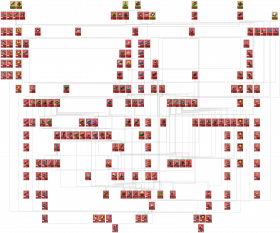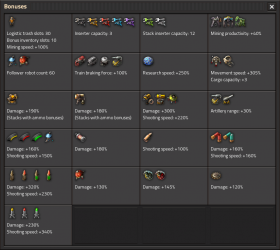テクノロジー
テクノロジー は サイエンスパックを使って、研究所で研究するものである。
すべてのテクノロジーは、研究するために一定量のサイエンスパックを必要とする。 例えば、物流テクノロジーを研究するテクノロジーに選択すると、20個の自動化サイエンスパックを研究所に置く必要がある。
実績

|
技術マニア すべてのテクノロジーを研究する |
- 技術マニアには、無限テクノロジーの研究を完了する必要はありません。無限に続くものの、無限ではないレベルのテクノロジーはすべて必要です。
無限テクノロジー
Factorioにおける大部分のテクノロジーは、1回きりか有限のレベルが数個存在するだけですが、一部は「無限」のものがあります。これは、プレイヤーが望む限りいくらでも多くのレベルを研究できるということです。 これらはすべて既存のテクノロジーにボーナスを追加するものであり、新しい構造や能力をもたらすものではありません。 レベルごとのボーナスは特定の無限テクノロジーに対して一定であり、有限の研究ボーナスのように、1つのテクノロジー内では加算的です。 そのため、非常に高いレベルの無限テクノロジーから得られるレベルごとおよびサイエンスパックの貢献は、最終的にはわずかな改善しかもたらしません。
すべての無限テクノロジーレベルはスペースサイエンスパックを必要とし、またスペースサイエンスパックを必要とする唯一のテクノロジーでもあります。 そのため、これらは主に、ロケット打ち上げという名目上の勝利条件を超えてプレイを続け、工場を拡張したいプレイヤーのためのゲーム後半のテクノロジーです。
無限テクノロジーは、ゲーム内では研究画面の研究テクノロジーカードの右上に表示される小さな∞無限マークで識別されます。
ほとんどの無限テクノロジーは通常の複数レベルテクノロジーの続きであり、プレイヤーが研究ツリーにおいて最初に N - ∞と書かれた カードに到達した時点で「無限」メカニズムが有効になる。
長距離砲関連の 2 つの技術(長距離砲射程と長距離砲弾連射速度)だけが最初から無限であり、これらについてはまだ研究する前から 1 - ∞ が表示される。いずれの場合も、最初の無限レベルが研究されると、カードのラベルは上述したものに切り替わる。
コスト計算式
The price of all infinite technologies is generated in a mathematical progression; for the majority of technologies, the progression is geometric, mostly in powers of 2. Two technologies - mining productivity and follower robot count - use an arithmetic progression instead.
以下の表は、すべての無限テクノロジーについて、その最初の無限レベル、最初の数回の無限レベルのコスト、コストの計算式、およびレベルごとのボーナスをまとめたものです。
We denote by N the current level of the research, by F the final non-infinite level of the research (hence F+1 is the first "infinite" level) and by P[N] the price of the research at level N.
| テクノロジー | ボーナス | サイエンスパック | F+1 | P[N] | P[F+1] | P[F+2] | P[F+3] | P[F+4] | P[F+5] | ... |
|---|---|---|---|---|---|---|---|---|---|---|
| ロボット移動速度 | +65% Robot Speed | 7 | 1,000 × 2^(N - F - 1) | 1,000 | 2,000 | 4,000 | 8,000 | 16,000 | ×2 | |
| 掘削効率 | +10% Mining Productivity | 4 | 2,500 × (N - F) | 2,500 | 5,000 | 7,500 | 10,000 | 12,500 | +2500 | |
| 物理ダメージ | +40% Bullet Damage +70% Turret Damage +40% Shotgun Shell Damage +100% Cannon Shell Damage |
7 | 1,000 × 2^(N - F - 1) | 1,000 | 2,000 | 4,000 | 8,000 | 16,000 | ×2 | |
| 強化爆薬 | +50% Rocket Damage +20% Grenade Damage +20% Landmine Damage |
7 | 1,000 × 2^(N - F - 1) | 1,000 | 2,000 | 4,000 | 8,000 | 16,000 | ×2 | |
| 高度な火炎放射 | +20% Flame Thrower Damage | 7 | 1,000 × 2^(N - F - 1) | 1,000 | 2,000 | 4,000 | 8,000 | 16,000 | ×2 | |
| エネルギーダメージ | +70% Laser Damage +70% Electric Damage +30% Beam Damage |
7 | 1,000 × 2^(N - F - 1) | 1,000 | 2,000 | 4,000 | 8,000 | 16,000 | ×2 | |
| 長距離砲射程 | +30% Artillery Shell Range | 1 | 1,000 × 2^(N - F) | 2,000 | 4,000 | 8,000 | 16,000 | 32,000 | ×2 | |
| 長距離砲弾連射速度 | +100% Artillery Speed | 1 | 1,000 + 1,000 × 3^(N - F - 1) | 2,000 | 4,000 | 10,000 | 28,000 | 82,000 | ×3 then - 2000 | |
| 追従ロボットの増加 | +10 Follower Robots | 7 | 100 × (N - F) + 900 | 1,000 | 1,100 | 1,200 | 1,300 | 1,400 | +100 |
累積コスト
As the price of most infinite technologies (specifically, those based on geometric progressions) increases very steeply, it may be a good idea for players to set realistic target levels for each of the infinite technologies they wish to pursue, and make their factory plans accordingly. To that end, the following properties of cumulative infinite research prices may be useful:
- For infinite technologies whose underlying equation is a powers-of-two geometric series, the cumulative price of the first
N - Finfinite levels (skipping the firstFlevel, so counting "infinite" levels only) is2 × P[N] - P[F+1]; i.e., twice the price of the final researched level, less the price of the first "infinite" level.- As N increases, this is approximated well by
2 × P[N] = P[N+1], so the cumulative cost of researching to levelNis about as much as researching levelN+1. - If one decides a level
Mwhich one considers the "highest feasible" with their current science pack production capacity, expanding said capacity by a factor ofXwill allow aboutlog[2](X)additional levels to be researched before the next level takes longer to research with the expanded capacity than levelM + 1would have taken with the pre-expansion production capacity. - For example, if one expands production capacity by a factor of 10, they will be able to research at least
floor(log[2](10)) = 3and at mostceiling(log[2](10)) = 4additional levels in a given technology before the exponential increase in price negates the speed benefits of their ×10 capacity expansion.
- As N increases, this is approximated well by
- The cumulative price of the first
N - Flevels of infinite technologies whose underlying equation is an arithmetic series is(N - F) × (P[N] + P[F + 1]) ÷ 2; i.e,N - Ftimes the mean of the prices of the first and last "infinite" level. For the Follower robot count (research), an additional900 × (N-F)need to be added.- Expanding production capacity by a factor of
X, as above, will in this case allow an additionalN × (X - 1)levels to be researched before the benefit of the expansion is wiped out (i.e., research progress speed drops to or below what it was pre-expansion).
- Expanding production capacity by a factor of
- The cumulative price of the first N levels of artillery shell shooting speed, the sole infinite technology whose underlying equation is a powers-of-three geometric series (equation type (2)) is
1.5 × P[N] - 0.5 × P[1]; i.e., 1.5 times the price of the final researched level, less half the price of the first level.
Note that these prices reflect research units, which will not be equal to science packs if productivity modules are used in labs. (In that case, the science pack requirement will be lower.)

